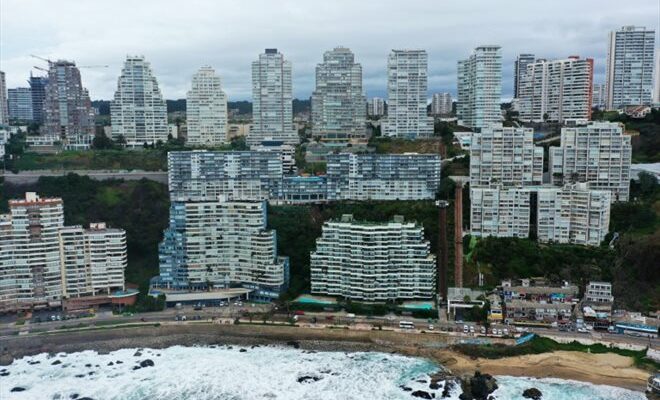Aerial view of the Euromarina II building in Reñaca, with a hole under its foundations, in Viña del Mar, Chile, June 12, 2024 (AFP/RODRIGO ARANGUA)
Dozens of buildings with breathtaking views of the sea built on a sand dune. The frenetic urban development of Valparaiso, one of the most touristic regions of Chile, is today under climatic threat, with the risk of several buildings collapsing.
A gaping hole 15 meters long and 30 meters deep opened on Sunday under the foundations of the Euromarina II building in Reñaca, the most exclusive seaside resort in Viña del Mar, 120 km from Santiago.
The 200 apartments on 13 floors, built in 2017 on the second line and some of which cost up to $500,000, were evacuated due to the risk of collapse.
Sergio Silva, 77, returned to load some belongings into a car, as more rain was forecast. “We are evacuating some important things, not everything (…) Everyone evacuated, for safety” and because the drinking water supply was cut off, Mr. Silva told AFP.
Some residents of the building below Euromarina II, at sea level, also evacuated, fearing that Euromarina II would collapse.
“Several left as a precaution. Those of us who remained prepared to have to evacuate urgently,” said Claudio Camus, a 43-year-old resident.

The gaping hole 15 meters long and 30 meters deep that opened under the foundations of the Euromarina II building in Reñaca, in Viña del Mar, Chile, June 12, 2024 (AFP/RODRIGO ARANGUA)
In August and September 2023, two landslides undermined the foundations of three other buildings: the Kandinsky, the Miramar-Reñaca and the Santorini. The coastal road was even cut for a time.
Euromarina II is located on a 28 hectare dune field which, until 1994, was part of a protected nature sanctuary. But a modification of the town planning rule authorized the construction of 44 luxury buildings.
“The risks taken by building here are gigantic,” Macarena Ripamonti, the mayor of Viña del Mar, told AFP.
The land was public but “it was sold in a shameless manner and it was possible to urbanize it because there was authorization to reduce the protected sector of the dune field,” she explains.
– Never here again –
The explosion of urbanization over the last 20 years on these dunes has not taken into account the extreme climatic phenomena which are intensifying, a consequence of the El Niño phenomenon or the effects of climate change.
“It’s a fragile area that should have been preserved,” said Ivan Poduje, urban planner and candidate for mayor of Viña del Mar. “What was done here was essentially to break a nasty rule (.. .) which made it possible to build too many buildings, there were undeniably very bad urban planning choices,” he adds.
The lack of rainwater collectors is pointed out to explain the gullies created on the sandy slopes.

Aerial view of rampant urban development in Reñaca and the Euromarina II building, with a hole under its foundations, in Viña del Mar, Chile, June 12, 2024 (AFP/RODRIGO ARANGUA)
“The network of collectors is quickly overwhelmed (…) With 42, 43 buildings, in an area with such a slope and such fragility,” explains Mr. Poduje.
For Luis Lopez, construction engineer and professor at the Catholic University of Valparaiso, however, a solution exists: “Change the arrangement of the collectors and bring the drainage from this part of the city to other sectors which would not present risks for buildings and would not affect the dune.
If structural work can avoid a potential catastrophe, the mayor of Viña del Mar is now categorical: “I will never allow another building to be built here.”
© 2024 AFP
Did you like this article ? Share it with your friends using the buttons below.




